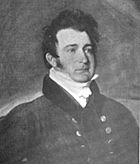George Howard (Governor of Maryland) facts for kids
Quick facts for kids
George Howard
|
|
|---|---|
 |
|
| 22nd Governor of Maryland | |
| In office July 11, 1831 – January 17, 1833 |
|
| Preceded by | Daniel Martin |
| Succeeded by | James Thomas |
| Personal details | |
| Born | November 21, 1789 Annapolis, Maryland |
| Died | August 2, 1846 (aged 56) Howard County, Maryland |
| Relatives | John Eager Howard (father) Peggy Chew Howard (mother) |
George Howard (born November 21, 1789 – died August 2, 1846) was an important political figure in Maryland, United States. He served as the 22nd Governor of Maryland from 1831 to 1833. He was known for his strong opinions against President Andrew Jackson's policies during his time in office. George Howard holds a unique place in history as the only son of a governor who also became a governor himself.
Contents
Early Life and Family
George Howard was born on November 21, 1789, in the Governor's Mansion in Annapolis, Maryland. His father was Governor John Eager Howard, a famous Revolutionary War hero. His mother was Margaret Oswald "Peggy" Chew.
The Howard family later moved to a place called "Belvidere" in Baltimore County, Maryland. George received his education from private tutors at home.
Marriage and Children
On December 26, 1811, George Howard married Prudence Gough Ridgely. Her father was also a governor, Charles Carnan Ridgely, who lived at a grand estate called Hampton.
As a wedding gift, George and Prudence received an estate called "Waverly" near Woodstock, Maryland. They settled there and had a very large family, with fourteen children in total.
Life as a Farmer and Politician
At "Waverly," George Howard lived the life of a country gentleman. He managed his farm and enjoyed rural life. However, he also became involved in state politics.
In January 1831, he was elected to the Governor's Council. This council worked closely with the current governor, Daniel Martin.
Becoming Governor
When Governor Martin sadly passed away in July 1831, George Howard was the President of the Council. This meant he took over as governor. He officially took the oath of office on July 22, 1831.
When Governor Martin's original term ended in January 1832, the Maryland General Assembly (the state's law-making body) elected George Howard for a full one-year term. He received a strong majority of the votes.
Governor Howard's Policies
During his time as governor, George Howard supported several important ideas. He believed Maryland should have its own State Bank. He also disagreed with the idea of "nullification", which was a belief that states could ignore federal laws they didn't like.
Governor Howard was also against lotteries, which were common ways to raise money back then. He strongly encouraged giving money to Maryland colleges to help them grow and educate more people.
Slavery and Colonization
Like many landowners of his time, George Howard owned enslaved people. However, he also showed interest in a movement that aimed to help free Black people move to Africa. He believed this system could, in the future, help all Black people return to their ancestral lands.
Later Life and Legacy
After his term as governor ended, George Howard returned to his home at "Waverly." He continued to be involved in politics, serving as a presidential elector in 1836 and 1840. In these elections, he supported the Whig political party's candidate.
George Howard passed away at his home on August 2, 1846. His exact final resting place is not known for sure, but it is believed he is buried in the Howard family vault at Old Saint Paul's Cemetery in Baltimore, Maryland. His father, John Eager Howard, is also buried there.
George Howard left his estate, "Waverly," and 22 enslaved people to his wife, Prudence. She passed away the following year, and the estate then went to their oldest son, George Jr.
Portraits
There are portraits of George Howard and his wife, Prudence. George Howard's portrait was painted by C. Gregory Stapko. Prudence Dorsey's portrait was painted by Philip Tilyard and can be found at the Hampton National Historic Site.


